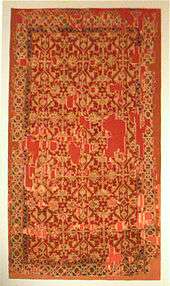Lotto carpet
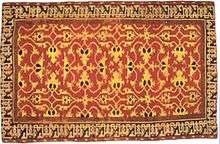
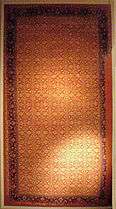
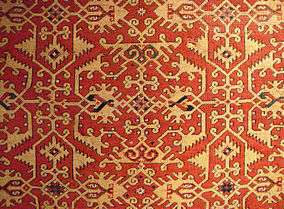
Right image: Design detail. Turkish and Islamic Arts Museum.

A Lotto carpet is a hand knotted carpet having a pattern that was primarily produced during the 16th and 17th centuries along the Aegean coast of Anatolia, Turkey, but also copied in various parts of Europe. It is characterized by a lacy arabesque, usually in yellow on a red ground, often with blue details. The name, "Lotto carpet", refers to the inclusion of carpets with this pattern in paintings by the 16th-century Venetian painter Lorenzo Lotto, though they in fact appear in many earlier Oriental carpets in Renaissance painting.
Lotto carpets used to be known as Small-pattern Holbein Type II by Western scholars, but Holbein never painted one, unlike Lorenzo Lotto who did so several times, though he was not the first artist to show them. Lotto is also documented as owning a large carpet, though its pattern is unknown. Though they look very different from Holbein Type I carpets, they are a development of the type, where the edges of the motifs take off in rigid arabesques somewhat suggesting foliage, and terminating in branched palmettes. The type was common and long-lasting, and is also known as "Arabesque Ushak".[1] They are still found in paintings by Murillo and Zurbarán in the 17th century, and Dutch paintings until the 1660s and sometimes later.[2]
Ellis distinguishes three principle design groups for Lotto carpets: the Anatolian-style, kilim-style, and ornamental style.[3]
In the 16th and 17th centuries they were copied in Italy, Spain, the European part of the Ottoman Empire, and even in England, and many modern copies have also been produced.[4]
 Sebastiano del Piombo's Cardinal Bandinello Sauli, with a Lotto carpet design, 1516.
Sebastiano del Piombo's Cardinal Bandinello Sauli, with a Lotto carpet design, 1516.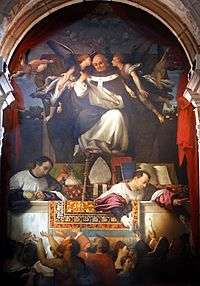 The Alms of St. Anthony, oil on wood painting by Lorenzo Lotto, showing a Lotto carpet, 1542.
The Alms of St. Anthony, oil on wood painting by Lorenzo Lotto, showing a Lotto carpet, 1542.
See also
Notes
- ↑ Cambell, p. 189. Old Ottoman carpets. Type II Holbein or "Lotto" Carpets. King and Sylvester, pp. 16, 67-70.
- ↑ King and Sylvester, p. 20.
- ↑ Ellis, Charles Grant (1975). The "Lotto" pattern as a fashion in carpets (1st ed.). Hamburg: Hauswedell. pp. 19–31.
- ↑ King and Sylvester, pp. 16, 67-70.
References
| Wikimedia Commons has media related to Lotto carpets. |
- Brown, David Alan, Peter Humfrey and Mauro Lucco Lorenzo Lotto: Rediscovered Master of the Renaissance, New Haven, Yale University Press, 1997.
- King, Donald and Sylvester, David eds. The Eastern Carpet in the Western World, From the 15th to the 17th century, Arts Council of Great Britain, London, 1983, ISBN 0-7287-0362-9
- Mack, Rosamond E., Bazaar to Piazza: Islamic Trade and Italian Art, 1300-1600, Los Angeles, University of California Press, 2002.
